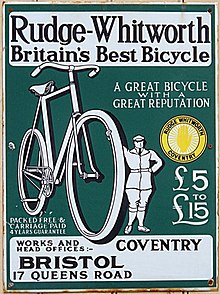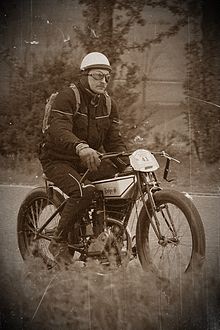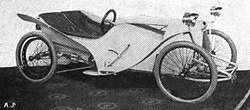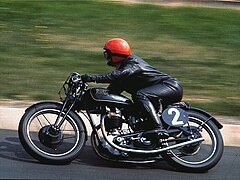The Honda XR series is a range of four-stroke off-road motorcycles that were designed in Japan but assembled all over the world.

A. J. Stevens & Co. Ltd was a British automobile and motorcycle manufacturer in operation from 1909 to 1931. The company was founded by Joe Stevens in Wolverhampton, England. After the firm was sold, the name continued to be used by Matchless, Associated Motorcycles and Norton-Villiers on four-stroke motorcycles until 1969, and since the name's resale in 1974, on lightweight, two-stroke scramblers and today on small-capacity roadsters and cruisers. The company held 117 motorcycle world records.

The Alcyon was a French bicycle, automobile and motorcycle manufacturer between 1903 and 1954.
The Scott Motorcycle Company was owned by Scott Motors (Saltaire) Limited, Saltaire, West Yorkshire, England and was a well-known producer of motorcycles and light engines for industry. Founded by Alfred Angas Scott in 1908 as the Scott Engineering Company in Bradford, Yorkshire, Scott motorcycles were produced until 1978.
Initially started in a rented workshop, Alfred moved the business to Hirstwood Works, Hirstwood Road, Saltaire. This building is still standing and has industrial use.

Excelsior, based in Coventry, was a British bicycle, motorcycle and car maker. They were Britain’s first motorcycle manufacturer, starting production of their own ‘motor-bicycle’ in 1896. Initially they had premises at Lower Ford Street, Coventry, and 287-295 Stoney Stanton Road, Hillfields, Coventry, Warwickshire before moving to Kings Road, Tyseley, Birmingham in 1921.

Matchless is one of the oldest marques of British motorcycles, manufactured in Plumstead, London, between 1899 and 1966. A wide range of models were produced under the Matchless name, ranging from small two-strokes to 750 cc four-stroke twins. Matchless had a long history of racing success; a Matchless ridden by Charlie Collier won the first single-cylinder race in the first Isle of Man TT in 1907.

A motorcycle engine is an engine that powers a motorcycle. Motorcycle engines are typically two-stroke or four-stroke internal combustion engines, but other engine types, such as Wankels and electric motors, have been used.

Wire wheels, wire-spoked wheels, tension-spoked wheels, or "suspension" wheels are wheels whose rims connect to their hubs by wire spokes. Although these wires are considerably stiffer than a similar diameter wire rope, they function mechanically the same as tensioned flexible wires, keeping the rim true while supporting applied loads. The term suspension wheel should not be confused with vehicle suspension.

The Cotton Motor Company, was a British motorcycle manufacturer of 11a Bristol Road, Gloucester, and was founded by Frank Willoughby Cotton in 1918. F.W. presided over the company until his retirement in 1953. The company was reconstituted as E. Cotton (Motorcycles) Ltd, and traded until 1980. The marque was later resurrected in the late 1990s by a business which manufactured replicas of earlier machines.
Robert Leslie Graham was a British motorcycle road racer who competed in the 1930s and 1940s. He won the inaugural Grand Prix motorcycle racing 500 cc World Championship in 1949.

Douglas was a British motorcycle manufacturer from 1907 to 1957 based in Kingswood, Bristol, owned by the Douglas family, and especially known for its horizontally opposed twin cylinder engined bikes and as manufacturers of speedway machines. The company also built a range of cars between 1913 and 1922.
Henry George Tyrell-Smith (1907–1982) was an Irish motorcycle road racer. He was born in Co Dublin and studied at Trinity College, Dublin for a B.A. And B.A.I.degree. He raced at the Isle of Man TT from 1927 to 1939, and between 1929 and 1936 competed in the German Grand Prix. He also raced in The Swedish Grand Prix in Saxtorp 1933–36.
FN is a Belgian company established in 1889 to make arms and ammunition, and from 1901 to 1967 was also a motorcycle manufacturer. FN manufactured one of the world's first four-cylinder motorcycles, was famous for the use of shaft drive in all models from 1903 to 1923, achieved success in sprint and long-distance motorcycle racing, and after 1945, also in motocross.

Peter Williams was a British former professional motorcycle racer. He competed in Grand Prix motorcycle road racing from 1966 to 1973. He also competed at many levels on home short-circuit races. He raced many times on the Isle of Man TT course from 1966 to 1973. His father was Jack Williams who ran the Associated Motor Cycles (AMC) race department. Williams trained in mechanical engineering and introduced via racing alloy wheels, an innovation which is commonplace on today's road bikes, and was also an early pioneer of solo-motorcycle disc brakes.

The Rudge Ulster was a British motorcycle manufactured by Rudge-Whitworth from 1929 until the outbreak of World War II.

The BSA C15 was a 250 cc single-cylinder ohv motorcycle manufactured by the British company BSA from September 1958 until 1967, and was BSA's first four-stroke unit-construction bike. For most of that period, after the introduction of 'Learner Laws' in 1961, a 250 cc was the largest capacity solo machine that a learner could ride unaccompanied when displaying L-plates in the United Kingdom. A road-going Sports derivative was added in 1961, and off-road versions, for Trials and Scrambles, were also available in the range.
The MV Agusta 203 Bialbero and MV Agusta 220 Bialbero were Italian factory racing motorcycles made by MV Agusta to compete in the 1955 250 cc World Motorcycle Racing Championship. The machine won three GPs and with it MV Agusta won that year's 250 cc Constructors Championship.

Bridgestone motorcycles were a division of the Bridgestone Tire Co. of Kyōbashi, Tokyo, Japan that produced mopeds and motorcycles from 1952 to 1970. Initially producing power assisted bicycles, the division moved on to producing mopeds and then motorcycles. The motorcycles were technologically advanced and powered by two-stroke engines. The high technical specification resulted in the machines being more expensive compared to other manufacturers models. Production was stopped in 1970 to protect the supply of tyres to other manufacturers.
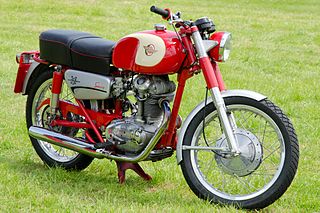
The Ducati Sebring is a 340 cc (21 cu in) single cylinder bevel drive SOHC motorcycle produced by the Italian manufacturer Ducati from 1965 to 1968. At the time of its introduction it was the largest capacity Ducati machine. Production of the original model ended in 1967 when the 'wide case' Mark 3 was introduced, although just over 200 Sebrings were made in 1968 with the 'wide case' engine. Total production was around 3,500 machines.
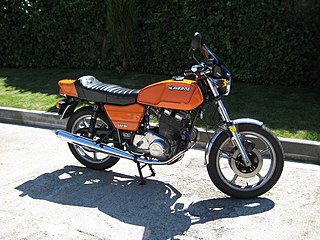
The Laverda 350/500 is a series of 345 cc (21.1 cu in) and 497 cc (30.3 cu in) air cooled DOHC 4 stroke parallel twin motorcycles produced by the Italian manufacturer Laverda from 1977 to 1983. The engine was used as the basis of future 650, 650, 668 and 750 cc models. Around 5,000 of these models were produced in total.
